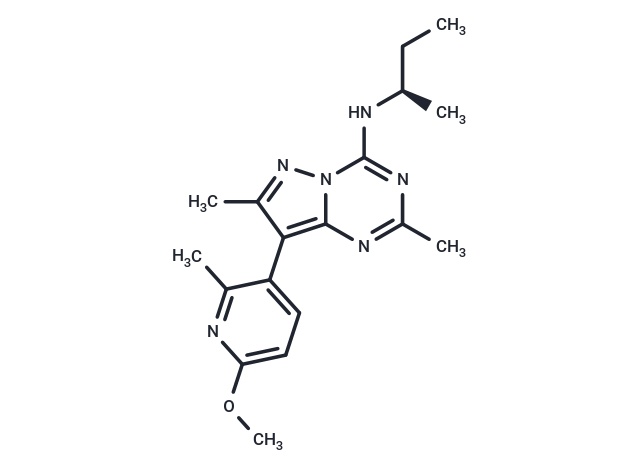Shopping Cart
Remove All Your shopping cart is currently empty
Your shopping cart is currently empty
Pexacerfont (BMS-562086) is a selective antagonist of the corticotropin-releasing factor receptor (IC50: 6.1±0.6 nM for the human CRF1 receptor).

| Pack Size | Price | USA Warehouse | Global Warehouse | Quantity |
|---|---|---|---|---|
| 1 mg | $40 | - | In Stock | |
| 5 mg | $89 | - | In Stock | |
| 1 mL x 10 mM (in DMSO) | $98 | - | In Stock |
| Description | Pexacerfont (BMS-562086) is a selective antagonist of the corticotropin-releasing factor receptor (IC50: 6.1±0.6 nM for the human CRF1 receptor). |
| Targets&IC50 | CRF1 receptor (human):6.1±0.6 nM |
| In vitro | Pexacerfont shows an effective and specific inhibitory effect (IC50=6.1 ± 0.6 nM) toward the human CRF1 receptor. It also has greater than 1000-fold lower affinity (IC50>1000 nM) for the CRF-binding protein and biogenic amine receptors[1]. |
| In vivo | Pexacerfont is active in rats (1-10 mg/kg, orally) in the defensive withdrawal and elevated plus-maze models of anxiety. The CLp of Pexacerfont was higher in rats (17.9 mL/kg per min) and dogs (11.6 mL/kg per min) than in chimpanzees (2.0 mL/kg per min). The plasma Pexacerfont concentrations exhibited a multiexponential decline in rats, dogs, and chimpanzees after the intravenous bolus dose. Assuming the value of CLp of Pexacerfont approximates the value of CLb in these three species, Pexacerfont has an estimated hepatic extraction ratio of 0.32, 0.38, and 0.08 in rats, dogs, and chimpanzees, respectively (calculated by dividing CLp by respective hepatic blood flow, 55.2, 30.9, and 25.5 mL/kg per min for rats, dogs, and chimpanzees). The assumption that CLb is equal to CLp is reasonable at least in rats, where the blood to the plasma concentration ratio of BMS-562086-equivalent radioactivity was 0.95 at 1 h postdose[1]. |
| Synonyms | BMS-562086 |
| Molecular Weight | 340.42 |
| Formula | C18H24N6O |
| Cas No. | 459856-18-9 |
| Smiles | CC[C@@H](C)Nc1nc(C)nc2c(c(C)nn12)-c1ccc(OC)nc1C |
| Relative Density. | 1.24 g/cm3 |
| Storage | store at low temperature | Powder: -20°C for 3 years | In solvent: -80°C for 1 year | Shipping with blue ice/Shipping at ambient temperature. | |||||||||||||||||||||||||||||||||||
| Solubility Information | DMSO: 45 mg/mL (132.19 mM), Sonication is recommended. | |||||||||||||||||||||||||||||||||||
| In Vivo Formulation | 10% DMSO+40% PEG300+5% Tween 80+45% Saline: 2 mg/mL (5.88 mM), Sonication is recommended. Please add the solvents sequentially, clarifying the solution as much as possible before adding the next one. Dissolve by heating and/or sonication if necessary. Working solution is recommended to be prepared and used immediately. The formulation provided above is for reference purposes only. In vivo formulations may vary and should be modified based on specific experimental conditions. | |||||||||||||||||||||||||||||||||||
Solution Preparation Table | ||||||||||||||||||||||||||||||||||||
DMSO
| ||||||||||||||||||||||||||||||||||||
| Size | Quantity | Unit Price | Amount | Operation |
|---|

Copyright © 2015-2026 TargetMol Chemicals Inc. All Rights Reserved.